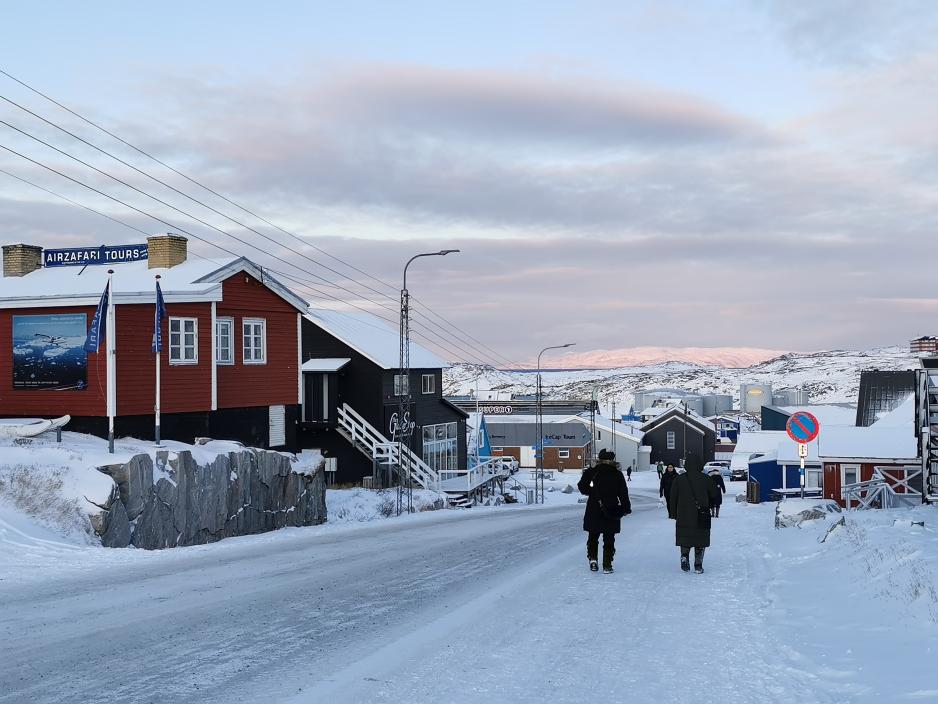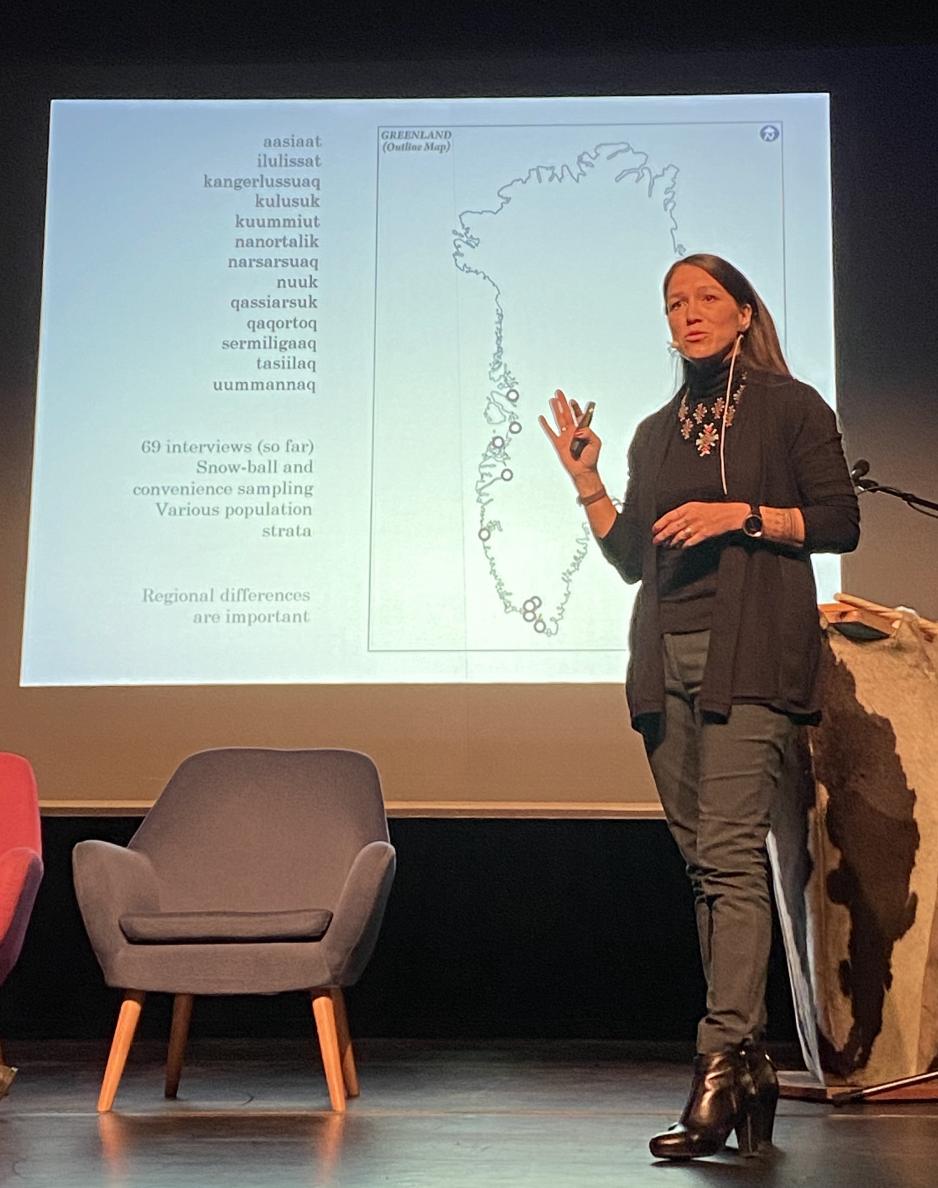What works for well-being in Greenland? Nature!

Naja Carina Steenholdt’s bottom-up research involves an extensive survey carried out in many Greenlandic towns and settlements. This photo is from her recent field trip to Ilulissat on Greenland’s west coast.
During ‘Greenland Science Week’, Naja Carina Steenholdt’s presentation about Greenlanders’ well-being attracted vast interest from both researchers and the wider public. One of the main findings of her comprehensive survey is that nature is the top-priority for Greenlanders’ across the country.
This is something Greenland’s decision-makers should be more aware of instead of simply “copy-pasting” solutions and systems from elsewhere, she suggests.
High North News met Steenholdt for an exclusive interview following her presentation in ‘Katuaq’ – a cultural venue in Nuuk.
HNN: What is the most important findings of your research on well-being in Greenland and, perhaps, the biggest surprise encountered so far?
Naja Carina Steenholdt: My most important finding so far is that contact with nature played a much larger role for the well-being of the people I talked with, than I had ever imagined. I interviewed almost 70 people and most of them perceived nature as very important in relation with having a good life. I had anticipated nature as being important beforehand, because state of the art literature on well-being in the Arctic often emphasize this. However, I found that nature was not just about, for instance, food safety and food security. In the North, nature is often connected with spirituality, in South Greenland people use nature as a source of emotional wellbeing, whereas in the East nature was emphasized as being most important in relation to well-being of the community as such.
To give a concrete example: I interviewed an East Greenlandic woman who expressed how important it was that the young and strong men would not only share their catch with the elders and those who are not able to hunt, but also offered a seat in their boat or snow mobile, so others also can get in contact with nature. Another woman stressed that it should be illegal to receive money from the elders and poor in exchange for catch, because they cannot hunt if they want to. In that sense, being able to have contact with nature was a community matter to some of the people I talked with. I found that quite interesting.
HNN: What has been your main motivation for doing research on this particular topic?
Naja Carina Steenholdt: I think the main driver for me is the social status quo in Greenland. We have so many unresolved societal issues and we lack efficient solutions to many of them. The positive well-being of people should be our grandest goal in society. In our social planning strategies we need to keep an extra careful eye on the people we are planning for. That is also why my well-being research has a bottom-up approach, because there are no greater sources of knowledge about people’s well-being than the people themselves. That might seem a bit ideological, but I do, indeed, think we can gain a lot from that perspective.
HNN: What could/should be done to possibly improve well-being in Greenland?
Naja Carina Steenholdt: First of all, we need to be more careful about copy-pasting from other societies and systems; especially the Danish ones. I know, that is so much easier and cost-friendly to just do what others do, but we need to open our eyes for the fact that we are a unique people with our own culture, traditions and life modes. Our quality of life solutions and strategies therefore need to be aligned with this. It seems so obvious, but in practice, I think we tend to look a little too much at other countries instead of looking at our own people and what could increase well-being here. Just think of my example about the importance of nature. Elderly people, who might be depressed and lonely. Mentally ill people who sits inside most of the day. And what about unemployed people, that are being put on some mindless activation program? It is not hard to imagine, that something as simple as contact with nature could prove to be a positive game changer in improving Greenlanders’ general well-being. And the possibilities for recreational contact with nature are – if not endless – then at least many. I think there is a great potential there. Last year, in the United Kingdom, doctors started prescribing recreational contact with nature on the Shetland Islands. I find that very interesting and I think we can learn something from that case. Recreational contact can never substitute the conventional medicinal practice which we have become so accustomed to, but I can think of many ways it can supplement it.
HNN: What is the ambition of your research? Both regarding the potential impact in Greenland and your own career?
Naja Carina Steenholdt: My own expectation of my research is that it can give a more nuanced picture of how quality of life and “the good life” is perceived among people in Greenland. My hope is then that policy makers and the governing bodies put that knowledge into use in social planning and strategies, especially on the areas where solutions are hard to find and where existing practice is insufficient.
Career-wise I am not sure yet. I love what I do, and basically I just really hope I can work with something that will make sense according to what I do today. It might be the biggest cliché in the history of that question, but I just really want to make a difference and be an active part of turning negative well-being into positive well-being in Greenland.
HNN: Your research has received a lot of positive attention recently – both here at Greenland Science Week and in the local news. Was that expected? Why/why not?
Naja Carina Steenholdt: I had an idea that people would find my project interesting, but I did not expect it to be at that magnitude. I think people will always be interested in research about well-being, because it is something that concerns us all. However, I think the large attention towards it might have something to do with the timing in Greenland. The political situation in the country right now is quite tense. Recently there has been two of the largest public protests, where a record-breaking number of people walked the streets to express their dissatisfaction with some of the political decisions made recently. For instance, in a matter of a few days and with no warning the taxes on sugar, alcohol, tobacco, cars and a number of other products were raised and that was just before Christmas and during boom times. These decisions effectively impact the quality of life of people and my research feeds directly into that context. But it could also have something to do with the focus of my presentation. My key message was to be more open about solutions and think nature into social planning and strategies and I think that resonated well with many in the sense that Greenlanders very much are a nature people.
HNN: In comparison with other parts of the Arctic, what do you think that other Arctic inhabitants could learn from Greenlanders’ way of living, and vice versa?
Naja Carina Steenholdt: I think there is a lot to be learned both ways. I think, in Greenland we are very good at protecting our cultural values and the sheer cultural diversity is something I will continue to learn from for the rest of my life. I know many nations are looking at us because of our cultural attachment and not least the process of becoming politically independent. But I think we can also learn from other nations, such as Alaska, Canada and Iceland. Especially when it comes to business sense. We both need to learn more about business internationally, but at the same time we also – and I cannot stress this enough – need to learn more about our own values. We have so much to offer as a people and we need to open our eyes for it.
Read more about Naja Carina Steenholdt’s research in this article published by The Arctic Institute: https://www.thearcticinstitute.org/what-works-wellbeing-greenland/

